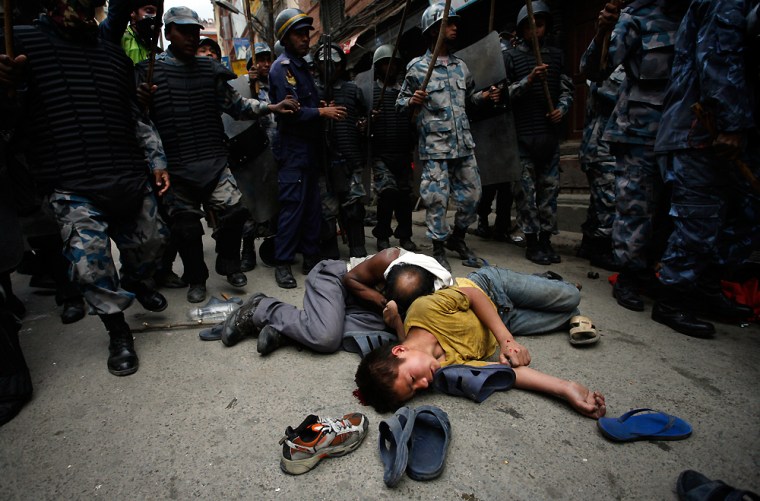Nepali security forces opened fire on a march by tens of thousands of demonstrators heading toward the royal palace Saturday to protest King Gyanendra’s rule. More than 200 were injured in the melee.
The demonstrators defied a curfew as an alliance of seven opposition parties rejected the king’s offer to let them nominate a prime minister and form a government. Security forces responded by firing rubber and live bullets and beating protesters with bamboo batons.
The Nepalese Red Cross Society said 243 people were injured and 39 of them were hospitalized. Many were hurt in stampedes as they tried to flee. The clash occurred about 3 miles from the royal palace in the heart of this Himalayan nation.
“Security forces opened fire on the crowd without warning, wounding many of us,” said Ganesh Shrestha, who was shot in the arm.
On Sunday, authorities imposed a daytime curfew for the fourth straight day to try to prevent more demonstrations.
Nepal’s crisis has escalated since a general strike called by the parties and communist rebels began two weeks ago. Protesters have filled the streets daily, leaving the country paralyzed, stores emptied of goods and the situation dangerously volatile. Security forces firing at protesters have killed at least 14, and wounded many more.
King’s offer rejected
Opposition leaders said the king’s offer to resolve a crisis that began after he seized power in February 2005 fell short of a key opposition demand; the return of parliament and creation of a special assembly to write a constitution.
Protests died down quickly in the afternoon when it started to rain and hail. By early evening, most demonstrators had retreated to narrow alleys or gone home.
Authorities later cut mobile phone services in Katmandu, a telecommunications official said, speaking on condition of anonymity because of the sensitivity of the situation. Protest organizers have repeatedly used mobile phones and text messages to rally demonstrators during more than two weeks of protests.
About 50,000 people also protested in the resort town of Pokhara, 125 miles west of Katmandu, urging the opposition parties not to give in to the king’s offer. The opposition leaders met with European diplomats, who urged them to consider the king’s offer.
The king addressed the nation Friday as tens of thousands flooded Katmandu’s streets for the second straight day. Gyanendra insisted he was acting on behalf of the nation his family has ruled since the 18th century.
“Executive power ... shall, from this day, be returned to the people,” he said in the announcement broadcast on state television and radio.
Political prisoners released
On Saturday, the government freed two senior Communist Party leaders arrested the day before, and police drove them to the party office in time for a meeting.
The leaders, Jhala Nath Khanal and Bamdev Gautam, have been important conduits in negotiations between the seven opposition parties and Maoist insurgents. The parties and insurgents have formed an alliance to protest the king’s seizure of power last year.
In a country where kings until recently have been revered as godlike, Gyanendra is deeply unpopular. Isolated in a collection of palaces, he has lost control of many rural areas to the Maoist rebellion, which has left nearly 13,000 people dead in its quest to create a communist Nepal.
Observers fear the country could descend into chaos, creating a power vacuum into which the Maoists could step.
In addition, many demonstrators are increasingly demanding that Gyanendra give up all his power — something the king is clearly loathe to do.
Most opposition leaders want a constitution that would make the king a ceremonial figure or eliminate the monarchy entirely. But under his plan the king would retain an undefined political role in a constitutional monarchy and apparently keep control of the military.
